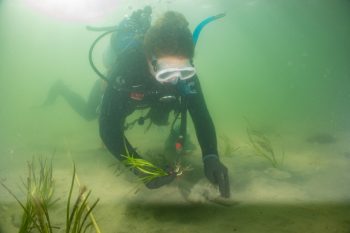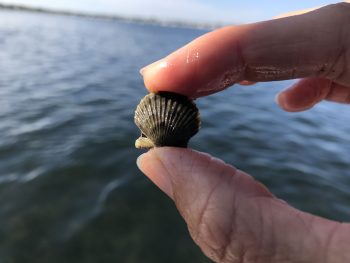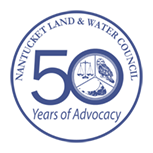Eelgrass is a marine flowering plant that provides the foundation for our harbor environment. The value of eelgrass meadows is well documented and includes stabilizing sediments, reducing wave energy, serving as a “carbon sink” to help offset our carbon footprint, and improve overall water quality. As our island community searches for answers to more severe storms and rising seas, we can look to nature for solutions that have been working for Nantucket for thousands of years. These meadows provide habitat for a number of commercially important and/or endangered species such as the last commercially viable “wild” bay scallop fishery in the U.S. The abundance and health of eelgrass has, however, diminished from historic levels in many areas. Over the years the Nantucket Land & Water Council (NLC) has supported eelgrass research that has revealed a need for action.
the foundation for our harbor environment. The value of eelgrass meadows is well documented and includes stabilizing sediments, reducing wave energy, serving as a “carbon sink” to help offset our carbon footprint, and improve overall water quality. As our island community searches for answers to more severe storms and rising seas, we can look to nature for solutions that have been working for Nantucket for thousands of years. These meadows provide habitat for a number of commercially important and/or endangered species such as the last commercially viable “wild” bay scallop fishery in the U.S. The abundance and health of eelgrass has, however, diminished from historic levels in many areas. Over the years the Nantucket Land & Water Council (NLC) has supported eelgrass research that has revealed a need for action.
Mapping and Restoration
In conjunction with the Town of Nantucket and a grant from the NLC and Great Harbor Yacht Club, Charles Costello from the Massachusetts Department of Environmental Protection conducted a detailed eelgrass survey of Nantucket. His results highlight the stark decline of eelgrass in the past few decades. Click here to read his report: 2015 Nantucket Eelgrass Mapping(PDF).
The Land Council, led by Dr. Alyssa Novak, Research Assistant Professor at Boston University, and with extensive support from a wide range of community partners including the Nantucket Natural Resources Department, Anderson’s Stillwater Moorings, The Sunken Ship and dozens of volunteers have successfully transplanted over 15,000 shoots of eelgrass from donor sites to the half acre restoration area in Nantucket Harbor.
The plants that survived have taken root and begun to spread across the area, both through their own root system and via seeds. The process would not have been a success without the assistance of the Nantucket Harbormaster Sheila Lucey and her team for closing the site to shell fishing and boating, as well as the good faith of scallopers, fisherfolk and boaters who have stayed out of the closed area as the plants recovered. For a detailed look at how the project has done so far, Dr. Novak’s latest progress report can be found here: ACK Eelgrass Restoration 2020
In 2021, NLC applied for and received an extension of the three year permit at the Monomoy restoration site to begin testing new methods of eelgrass restoration. While our project has been successful, diving to physically transplant shoots of eelgrass on the Harbor bottom is slow and expensive work requiring certified scuba divers and equipment. We are starting to test new seeding methods that will be more cost effective and less time consuming, allowing us to restore larger areas of Nantucket’s harbors in less time. These seeding methods, which involve collecting adult reproductive eelgrass shoots and holding them in flow-through tanks until they drop their seeds, have been successfully applied in other areas such as Chesapeake Bay and even China! There are a number of factors such as currents, seed predators, and human interference that can affect how these methods will perform, so NLC is working with Dr. Novak and the Nantucket Natural Resources Department on a pilot seeding project.
In Spring 2022, we also hope to begin seeding work at a new restoration site off of Coatue’s 4th Bend- another area that held abundant eelgrass a short time ago. This ongoing restoration work is being supported by a generous grant from The Agua Fund.
 The NLC will continue to use the information we collect, comparing it to other eelgrass communities in our region, and work to improve this critical natural resource through research, education, and advocacy.
The NLC will continue to use the information we collect, comparing it to other eelgrass communities in our region, and work to improve this critical natural resource through research, education, and advocacy.
The Nantucket Land & Water Council contracted with Dr. Alyssa Novak, to conduct an Eelgrass Health Assessment in 2018. Physiological characteristics of eelgrass meadows at 6 locations were evaluated including leaf length and width, plant density, above and below ground biomass, and epiphyte cover. Sediment cores and eelgrass tissue samples were analyzed for nutrient content, and environmental conditions were monitored with the installation of temperature and light sensors throughout the harbor.
In 2020 the NLC and Dr. Novak expanded this work to Madaket Harbor. Stay tuned for updates a final assessment of Madaket eelgrass coming soon. This health assessment research was made possible by a Great Harbor Yacht Club/Nantucket Land & Water Council Marine Grant with support from the Nantucket Shellfish Association. We thank the GHYC and the NSA for their support. Read the full Nantucket Harbor assessment here:2018 NLC Nantucket Harbor Eelgrass Health Assessment
The NLC will continue to assess the overall health of eelgrass meadows throughout Nantucket and Madaket harbors to look at nutrient impacts to eelgrass in Nantucket and compare it to the health of eelgrass in other regional communities along the North Shore and Cape Cod.
Your contributions to The Water Fund enable the NLC to continue working with eelgrass specialists from Boston University to oversee and assist with the health assessment and restoration work. Click here to join us in protecting and preserving our water resources!
